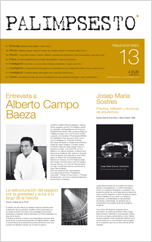EL EDIFICIO URBANO COMO GESTO CÍVICO
DOI:
https://doi.org/10.5821/palimpsesto.13.3980Keywords:
casa, ciudad, viviendas entre medianeras, urbano, cívico, Francisco Candel Jiménez, AlbaceteAbstract
La relación dialéctica entre la casa y la ciudad es el tema de este breve discurso, partiendo del modelo clásico, que Alberti formula y describe, y pasando a través de los sucesivos modelos, romántico burgués, moderno y posmoderno, para llegar a definir el sentido, en el entorno actual, de la casa entre medianeras que la limitan jurídica y físicamente. La posibilidad de observar el canon moderno, sin renunciar a una convincente inserción del modelo en la ciudad de ascendencia burguesa, se argumenta por medio de dos ejemplos tomados del mismo arquitecto, Francisco Candel Jiménez, en el ensanche de una ciudad de provincias, Albacete, tratando de demostrar que se puede ser rigurosamente moderno en el lenguaje y, a la vez, obediente a los límites urbanos establecidos. En el primer caso, un edificio de tres plantas para vivienda y estudio de arquitectura en entreplanta, la modestia del entorno no impide que el edificio inscrito en él sea a la vez altamente singular sin sustraerse a las reglas del planeamiento oficial. En el segundo, edificio de viviendas en cinco alturas más ático, y “atendiendo a su carácter urbano y a la actualidad de soluciones técnicas y constructivas”, despliega una amplia ceremonia de cortesía, que, por medio de los recursos propios de una avanzada high-tech, juega con los ritmos de su doble límite, doméstico y urbano, y hace que su modernidad radical eleve la dignidad del vecindario urbano que lo acompaña, sin alzar la voz, pero transmitiendo una lección de arquitectura que hace ciudad
Downloads
Published
Issue
Section
License
PROTECTION AND INTELLECTUAL PROPERTY CRITERIA
Authors whose work is published in en Palimpsesto agree to the following terms:
1. The author retains the copyrights and guarantees the magazine the right to apply a Creative Commons Attribution-NonCommercial-NoDerivatives (CC BY-NC-ND), which permits others to share the work with acknowledgement of authorship.
2. The author may establish additional agreements of his or her own accord for non-exclusive distribution of the article published in the magazine (for example, in an institutional repository, or published in a book).
3. Electronic distribution of the work by the author(s) is permitted and encouraged (for example, in institutional repositories or on the author’s own website), prior to, and during the submission process, as this can generate productive exchanges, as well as earlier and greater citation of the published works (see The Effect of Open Access) (in English).
4. The author or provider of the material submitted for publication authorizes Palimpsesto to publish, with no obligation whatsoever (financial or otherwise) to the content of said material, be it in paper or digital format, or in any other medium.
5. The author or provider guarantees that he or she is the owner of the Intellectual Property rights to the contents provided, which encompasses the text and images/photographs/photographic works incorporated in the article.
6. The author or provider, exempts Palimpsesto magazine of all and any responsibility relating to violation of copyrights, thereby committing himself or herself to undertaking all efforts to assist Palimpsesto magazine in defence of any accusation, extra-judiciary, and/or judicial measures. Likewise, the author or provider will assume payment to Palimpsesto of any sum or compensation that must be paid to third parties for failure to comply with these obligations, be it the result of judicial, arbitrary or administrative decisions.
7. The submission of the texts by authors implies automatically a declaration of non plagiarism of its contents







